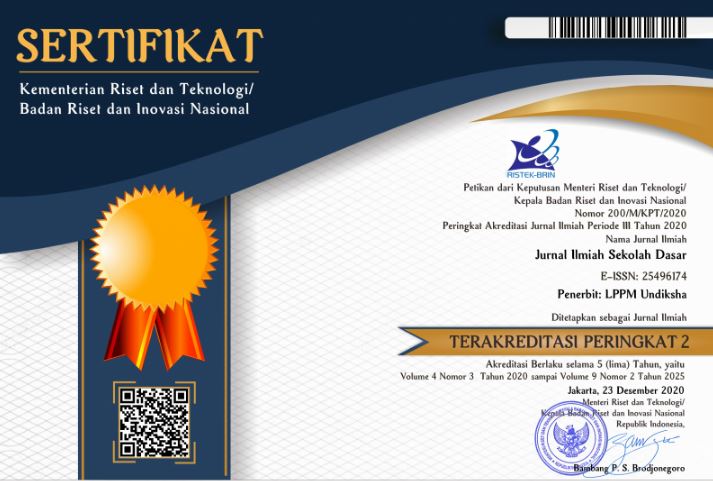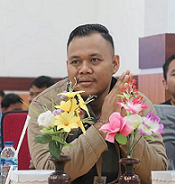The Impact of Storyboard That Media on Students' Critical Thinking Skills in Social Sciences Subjects in Elementary Schools
DOI:
https://doi.org/10.23887/jisd.v8i2.58854Keywords:
Media Storyboard That, Critical Thinking Skills, Social studiesAbstract
In the current era of digital technology development, free-access design platforms can be used in education as an alternative technology-based learning medium. Researchers found that in elementary schools, social studies learning still used conventional methods such as lectures and very rarely used instructional media, so students were bored while studying. Therefore, this study aimed to analyze the effect of using Storyboard That media on students' critical thinking skills on the material of the Proclamation of Independence. This study used the Storyboard That website along with 5 essay questions with a cognitive level of C4-C6 (analyze, evaluate, create). This research is a Quasi-Experimental with Non-equivalent Control Group Design. The number of samples consisted of class VI A totaling 22 students as the control class and class VI B totaling 22 students as the experimental class. Data analysis techniques consisted of prerequisite tests of normality and homogeneity tests and Independent Sample T-tests. The Independent Sample T-test data results on the pretest data were 0.539 > 0.05 and the post-test. (2-tailed) of 0.000 <0.05. So, it can be concluded that there were significant differences in students' critical thinking skills between the experimental group that used Storyboard That media and the control class that only used conventional lecturing methods. It is proven that Storyboard That encourages students to think critically through various visualization stimuli. This implementation allows teachers to use it as appropriate social studies learning media to improve elementary school students' critical thinking skills.
References
Agus, O., Shavab, K., Supriatna, N., Yulifar, L., & Mulyana, A. (2022). Fostering Creative Thinking Through Gamification in History Learning. Proceedings of the Annual Conference on Research, Educational Implementation, Social Studies and History (AREISSH 2021), 144–150. https://doi.org/10.2991/978-2-494069-17-6_16. DOI: https://doi.org/10.2991/978-2-494069-17-6_16
Alit, K., Adnyani, D., Wibawa, I. M. C., & Margunayasa, I. G. (2021). Alternative Energy Sources on Digital Comic Media. International Journal of Elementary Education, 5(1), 61–70. https://doi.org/10.23887/ijee.v5i1.34333. DOI: https://doi.org/10.23887/ijee.v5i1.34333
Apriliana, L. P., Handayani, I., & Awalludin, S. A. (2019). The Effect of a Problem Centered Learning on Student’s Mathematical Critical Thinking. JRAMathEdu (Journal of Research and Advances in Mathematics Education), 4(2), 124–133. https://doi.org/10.23917/jramathedu.v4i2.8386. DOI: https://doi.org/10.23917/jramathedu.v4i2.8386
Aprilliyah. (2014). Pengembangan Media Pembelajaran Modul Interaktif Pada Materi Jurnal Khusus Kelas X Akuntansi di SMK Negeri Mojoagung. Jurnal Khusus, 2(2), 1–7. https://jurnalmahasiswa.unesa.ac.id/index.php/35/article/view/9412.
Arfiani, D. D., Ulya, H., & Wanabuliandari, S. (2020). The Effect of REACT Model Assisted Fable-Math Book Media on Mathematical Problem Solving Of Elementary School Students. Mathematics Education Journal, 4(2), 116–125. https://doi.org/10.22219/mej.v4i2.12523. DOI: https://doi.org/10.22219/mej.v4i2.12523
Ariani, T. (2020). Analysis of Students’ Critical Thinking Skills in Physics Problems. Kasuari: Physics Education Journal (KPEJ), 3(1), 1–17. https://doi.org/10.37891/kpej.v3i1.119. DOI: https://doi.org/10.37891/kpej.v3i1.119
Astiwi, K. P. T., Antara, P. A., Agustiana, & T., I. G. A. (2020). Pengembangan Instrumen Penilaian Kemampuan Berpikir Kritis Siswa SD pada Mata Pelajaran PPKn. Jurnal Ilmiah Pendidikan Profesi Guru, 3(3), Ilmiah Pendidikan Profesi Guru, 3(3), 459. https://ejournal.undiksha.ac.id/index.php/JIPPG/article/view/29457/0. DOI: https://doi.org/10.23887/jippg.v3i3.29457
Astuti, A. P., Aziz, A., Sumarti, S. S., & Bharati, D. A. L. (2019). Preparing 21st Century Teachers: Implementation of 4C Character’s Pre-Service Teacher through Teaching Practice. Journal of Physics: Conference Series, 1233(1). https://doi.org/10.1088/1742-6596/1233/1/012109. DOI: https://doi.org/10.1088/1742-6596/1233/1/012109
Blumberg, F. C., & Fisch, S. M. (2013). Introduction: Digital games as a context for cognitive development, learning, and developmental research. New Directions for Child and Adolescent Development, 139, 1–9. https://doi.org/10.1002/cad.20026. DOI: https://doi.org/10.1002/cad.20026
Boonprasom, C., & Sintanakul, K. (2020). The Development of Collaborative Learning Management System Using Problem-Based on Cloud Learning to Enhance Critical Thinking. 2020 7th International Conference on Technical Education (ICTechEd7), 13–18. https://doi.org/10.1109/ICTechEd749582.2020.9101249. DOI: https://doi.org/10.1109/ICTechEd749582.2020.9101249
Chen, H., & Chuang, Y. (2021). The effects of digital storytelling games on high school students’ critical thinking skills. Journal of Computer Assisted Learning, 37(1), 265–274. https://doi.org/10.1111/jcal.12487. DOI: https://doi.org/10.1111/jcal.12487
Csima, M., Fináncz, J., Nyitrai, Á., & Podráczky, J. (2018). Research on the health literacy of professionals working in early childhood education. Kontakt, 20(4), e356–e362. https://doi.org/10.1016/j.kontakt.2018.10.002. DOI: https://doi.org/10.1016/j.kontakt.2018.10.002
Dam, M., Ottenhof, K., Van Boxtel, C., & Janssen, F. (2019). Understanding cellular respiration through simulation using lego as a concrete dynamic model. Education Sciences, 9(2), 72. https://doi.org/10.3390/educsci9020072. DOI: https://doi.org/10.3390/educsci9020072
Dopo, F. B., & Ismaniati, C. (2016). Persepsi guru tentang digital natives, sumber belajar digital dan motivasi memanfaatkan sumber belajar digital. Jurnal Inovasi Teknologi Pendidikan, 3(1), 13–24. https://doi.org/10.21831/tp.v3i1.8 280. DOI: https://doi.org/10.21831/tp.v3i1.8280
Eliana, N. (2020). Analisis Kemampuan Berpikir Kritis Siswa dalam Menyelesaikan Soal-Soal Ipa Berorientasi Hots. Jurnal Pendidikan Dasar, 11(2), 170–180. https://doi.org/10.21009/JPD.011.18. DOI: https://doi.org/10.21009/jpd.v11i02.18675
Elmahdi, I., Al-Hattami, A., & Fawzi, H. (2018). Using Technology for Formative Assessment to Improve Students’ Learning. Turkish Online Journal of Educational Technology-TOJET, 17(2), 182–188. https://eric.ed.gov/?id=EJ1176157.
Fahyuni, E. F., & Fauji, I. (2017). Pengembangan Komik Akidah Akhlak Untuk Meningkatkan Minat Baca dan Prestasi Belajar Siswa di Sekolah Dasar. Halaqa: Islamic Education Journal, 1(1), 17–26. https://doi.org/10.21070/halaqa.v1i1.817. DOI: https://doi.org/10.21070/halaqa.v1i1.817
Febriansyah, D., Dwiputra, K., Budiyanto, T. M., & Adz, T. (2020). Textbooks Transformation Into Digital Comics As Innovative Learning Media for Social Science Studies in Junior High School. International Journal Pedagogy of Social Studies, 5(2), 9–16. https://doi.org/10.17509/ijposs.v5i2.29068.
Fitriyani, Y., Eliyanti, M., & Lestari, M. A. (2021). The Application Of Comic Media To Improve Literature Ability In Understanding Mathematics Story Problems In Elementary School. AULADUNA: Jurnal Pendidikan Dasar Islam, 8(2), 168–179. https://doi.org/10.24252/auladuna.v8i2a5.2021. DOI: https://doi.org/10.24252/auladuna.v8i2a5.2021
Ghofur, A., & Youhanita, E. (2020). Interactive Media Development to Improve Student Motivation. IJECA (International Journal of Education and Curriculum Application), 3(1), 1–11. https://doi.org/10.31764/ijeca.v3i1.2026. DOI: https://doi.org/10.31764/ijeca.v3i1.2026
Hanif, M. (2020). The Development And Effectiveness Of Motion Graphic Animation Videos To Improve Primary School Students’ Sciences Learning Outcomes. International Journal of Instruction, 13(4), 247–266. https://doi.org/10.29333/iji.2020.13416a. DOI: https://doi.org/10.29333/iji.2020.13416a
Haseski, H. I., Ilic, U., & Tugtekin, U. (2018). Defining a New 21st Century Skill-Computational Thinking: Concepts and Trends. International Education Studies, 11(4), 29. https://doi.org/10.5539/ies.v11n4p29. DOI: https://doi.org/10.5539/ies.v11n4p29
Jumardi, J. (2017). Peranan Pelajaran Sejarah Dalam Pengembangan Karakter Siswa Melalui Pembelajaran Berbasis Nilai Sejarah Lokal di SMA Negeri 65 Jakarta Barat. Jurnal Pendidikan Sejarah, 6(2), 70–80. https://doi.org/10.21009/jps.062.08. DOI: https://doi.org/10.21009/JPS.062.08
Kakosimos, K. E. (2015). Example of a micro-adaptive instruction methodology for the improvement of flipped-classrooms and adaptive-learning based on advanced blended-learning tools. Education for Chemical Engineers, 12, 1–11. https://doi.org/10.1016/j.ece.2015.06.001. DOI: https://doi.org/10.1016/j.ece.2015.06.001
Kautsar, I. A., Kubota, S., Musashi, Y., & Sugitani, K. (2016). Lecturer Based Supportive Tool Development and Approaches for Learning Material Sharing under Bandwidth Limitation. Journal of Information Processing, 24(2), 358–369. https://doi.org/10.2197/IPSJJIP.24.358. DOI: https://doi.org/10.2197/ipsjjip.24.358
Kembara, M. D., Rozak, R. W. A., & Hadian, V. A. (2019). Research-based Lectures to Improve Students’ 4C (Communication, Collaboration, Critical Thinking, and Creativity) Skills. Proceedings of the International Symposium on Social Sciences, Education, and Humanities (ISSEH 2018). https://doi.org/10.2991/isseh-18.2019.6. DOI: https://doi.org/10.2991/isseh-18.2019.6
Kilis, S., & Yildirim, Z. (2019). Posting Patterns of Students’ Social Presence, Cognitive Presence, and Teaching Presence in Online Learning ONLINE LEARNING. Online Learning, 23(2), 179–195. https://avesis.metu.edu.tr/yayin/c602500e-43ee-41cb-8d82-1240bba9f249/posting-patterns-of-students-social-presence-cognitive-presence-and-teaching-presence-in-online-learning. DOI: https://doi.org/10.24059/olj.v23i2.1460
Kunto, I., Ariani, D., Widyaningrum, R., & Syahyani, R. (2021). Ragam Storyboard Untuk Produksi Media Pembelajaran. Jurnal Pembelajaran Inovatif, 4(1), 108–120. https://doi.org/10.21009/jpi.041.14. DOI: https://doi.org/10.21009/JPI.041.14
Marsa, P. B., & Desnita, D. (2020). Analisis Media, Sumber Belajar, dan Bahan Ajar Yang Digunakan Guru Fisika SMA Materi Gelombang Di Sumatera Barat Ditinjau Dari Kebutuhan Belajar Abad 21. Jurnal Eksakta Pendidikan (Jep), 4(1), 81. https://doi.org/10.24036/jep/vol4-iss1/422. DOI: https://doi.org/10.24036/jep/vol4-iss1/422
Nisak, N. M., Arifin, M. B. U. B., Fahyuni, E. F., & Rahmawati, I. M. (2021). The Development of Comic Formatted Fiqh Textbook for Islamic Elementary School. European Journal of Education Studies, 8(1), 114–125. https://doi.org/10.46827/ejes.v8i1.3513.
Nofrion, N., & Wijayanto, B. (2018). Learning activities in higher order thinking skill (HOTS) oriented learning context. Geosfera Indonesia, 3(2), 122. https://doi.org/10.19184/geosi.v3i2.8126. DOI: https://doi.org/10.19184/geosi.v3i2.8126
Oktaviana, D. L., & Rusnilawati. (2022). Role Playing with Digital Comics in Preventing Bullying and Cyberbullying Behavior in Elementary School. Jurnal Ilmiah Sekolah Dasar, 6(4), 603–609. https://doi.org/https://doi.org/10.23887/jisd.v6i4.53685. DOI: https://doi.org/10.23887/jisd.v6i4.53685
Phoon, H.-Y., Roslan, R., Shahrill, M., & Said, H. M. (2020). The Role of Comics in Elementary School Science Education. Formatif: Jurnal Ilmiah Pendidikan MIPA, 10(2), 67–76. https://doi.org/10.30998/formatif.v10i2.6257. DOI: https://doi.org/10.30998/formatif.v10i2.6257
Pujiastuti, H., & Haryadi, R. (2023). Higher-Order Thinking Skills Profile of Islamic Boarding School Students on Geometry through the STEM–based Video Approach. International Journal of STEM Education for Sustainability, 3(1). https://doi.org/10.53889/ijses.v3i1.135. DOI: https://doi.org/10.53889/ijses.v3i1.135
Qoiruni, S., & Wicaksono, V. D. (2022). Pengembangan Komik Digital Untuk Materi Pengamalan Nilai-Nilai Pancasila dalam Permainan Tradisional Kelas V SD. Jurnal Penelitian Pendidikan Guru Sekolah Dasar, 10(4), 792–803. https://doi.org/https://ejournal.unesa.ac.id/index.php/jurnal-penelitian-pgsd/article/view/46427.
Rahmawati, F., & Ramadan, Z. H. (2021). Improving High-Level Thinking Skills in Students Through Powtoon-Based Animation Video Media. Journal of Education Technology, 5(4), 654. https://doi.org/10.23887/jet.v5i4.41037. DOI: https://doi.org/10.23887/jet.v5i4.41037
Rina, N., Suminar, J. R., Damayani, N. A., & Hafiar, H. (2020). Character education based on digital comic media. International Journal of Interactive Mobile Technologies, 14(3), 107–127. https://doi.org/10.3991/ijim.v14i03.12111. DOI: https://doi.org/10.3991/ijim.v14i03.12111
Rustandi, A., & Rismayanti. (2021). Penerapan Model ADDIE dalam Pengembangan Media Pembelajaran di SMPN 22 Kota Samarinda. Jurnal Fasilkom, 11(2), 57–60. https://doi.org/10.37859/jf.v11i2.2546. DOI: https://doi.org/10.37859/jf.v11i2.2546
Sarah, F., Khaldun, I., & Gani, A. (2021). The Development Higher Order Thinking Skill (Hots) As Questions In Chemistry Study (Solubility And Solubility Product Constant). Jurnal Pendidikan Sains (Jps), 9(1), 51. https://doi.org/10.26714/jps.9.1.2021.51-60. DOI: https://doi.org/10.26714/jps.9.1.2021.51-60
Satriyo Pamungkas, H. A. (2022). Strategi Pembelajaran IPS Masa Pandemi Covid-19 Di SMP Laboratorium Kota Jambi. Istoria: Jurnal Ilmiah Pendidikan Sejarah Universitas Batanghari Jambi, 5(2), 24–39. https://doi.org/10.33087/istoria.v5i2.112. DOI: https://doi.org/10.33087/istoria.v5i2.112
Seo, K., Tang, J., Roll, I., Fels, S., & Yoon, D. (2021). The impact of artificial intelligence on learner–instructor interaction in online learning. International Journal of Educational Technology in Higher Education, 18(1), 54. https://doi.org/10.1186/s41239-021-00292-9. DOI: https://doi.org/10.1186/s41239-021-00292-9
Setiawan, J., Aman, & Wulandari, T. (2020). Understanding Indonesian history, interest in learning history and national insight with nationalism attitude. International Journal of Evaluation and Research in Education, 9(2), 364–373. https://doi.org/10.11591/ijere.v9i2.20474. DOI: https://doi.org/10.11591/ijere.v9i2.20474
Siregar, R., Setiawan, D., & Hadiningrum, S. (2019). The Development of Social Studies Learning Based on Local Wisdom to Improve Students’ Social Skills at Social Science Faculty of Universitas Negeri Medan. In 1st International Conference on Social Sciences and Interdisciplinary Studies (ICSSI). https://doi.org/10.2991/icssis-18.2019.71. DOI: https://doi.org/10.2991/icssis-18.2019.71
Sugiyono. (2019). Metode Penelitian Pendidikan (Kualitiatif, Kualitatif, Kombinasi, R&D dan Penelitian Pendidikan. Alfabeta.
Sukatiman, S., Akhyar, M., Siswandari, & Roemintoyo. (2020). Enhancing higher-order thinking skills in vocational education through scaffolding-problem based learning. Open Engineering, 10(1), 612–619. https://doi.org/10.1515/eng-2020-0070. DOI: https://doi.org/10.1515/eng-2020-0070
Virijai, F., Asrizal, A., & Festiyed, F. (2022). Meta Analisis Pengaruh Bahan Ajar Terhadap Kemampuan Berpikir Kritis Siswa Dalam Menghadapi Era Revolusi 4.0. Jurnal Penelitian Pembelajaran Fisika, 8(1), 54. https://doi.org/10.24036/jppf.v8i1.115806. DOI: https://doi.org/10.24036/jppf.v8i1.115806
Yulian, V. N. (2018). Developing Teaching Materials Using Comic Media to Enhance Students’ Mathematical Communication. IOP Conference Series: Materials Science and Engineering, 335(1), 012110. https://doi.org/10.1088/1757-899X/335/1/012110. DOI: https://doi.org/10.1088/1757-899X/335/1/012110
Zeptyani, & Wiarta. (2020). Pengaruh Project-Based Outdoor Learning Activity Menggunakan Media Audio Visual Terhadap Perilaku Belajar Anak Usia Dini. Jurnal Pendidikan Anak Usia Dini Undiksha, 8(2), 69–79. https://doi.org/10.23887/paud.v8i2.24740.
Downloads
Published
How to Cite
Issue
Section
License
Copyright (c) 2024 Neng Ranti, Muhammad Hanif

This work is licensed under a Creative Commons Attribution-ShareAlike 4.0 International License.
Authors who publish with the Journal Ilmiah Sekolah Dasar agree to the following terms:
- Authors retain copyright and grant the journal the right of first publication with the work simultaneously licensed under a Creative Commons Attribution License (CC BY-SA 4.0) that allows others to share the work with an acknowledgment of the work's authorship and initial publication in this journal.
- Authors are able to enter into separate, additional contractual arrangements for the non-exclusive distribution of the journal's published version of the work (e.g., post it to an institutional repository or publish it in a book), with an acknowledgment of its initial publication in this journal.
- Authors are permitted and encouraged to post their work online (e.g., in institutional repositories or on their website) prior to and during the submission process, as it can lead to productive exchanges, as well as earlier and greater citation of published work. (See The Effect of Open Access)










